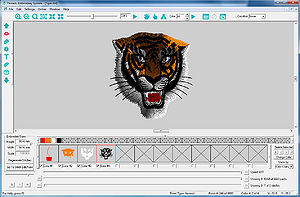Difference between revisions of ".dst"
| (16 intermediate revisions by the same user not shown) | |||
| Line 1: | Line 1: | ||
A file with a .dst file extension is a design file intended for embroidery machines. The common .dst extension is a stitch-based file format popularized by Tajima commercial embroidery sewing machines. To open a .dst file requires embroidery digitizing software. | [[File:Threads_screen_shot.jpg|thumb|right|alt=.dst file in digitizing program|A .dst file open in a digitizing software program]] | ||
A file with a '''.dst file extension''' is a design file intended for embroidery machines. The common .dst extension is a stitch-based file format popularized by '''[[Tajima]]''' commercial embroidery sewing machines. The DST nomenclature stands for Data Stitch Tajima. To open a .dst file typically requires some type of embroidery '''[[digitizing]]''' software. | |||
==Universal standard== | |||
In an industry filled with proprietary file formats, the Tajima .dst file has become something of a universal standard in embroidery in that it is able to be read by nearly all embroidery machines and embroidery software. | |||
==.dst files and color== | |||
The Tajima .dst format is a dependable commercial format that has been around since before the era of modern computers. For that reason, the Tajima .dst file can not store the color palette. It does not have the ability to save RGB (red, green, blue) color values at the color changes. | |||
Even though the (.dst) data does not contain specific thread color information, the Tajima file type remains the most common format found in the embroidery industry. | |||
==.dst file naming convention== | |||
The correct naming convention for a Tajima .dst file is gXXX.dst where the letter g is lowercase and the 3 Xs represent numerical values from 001 - 099 not to exceed or equal 100. If a user does not abide to these naming conventions it is possible that the embroidery machine will not be able to read, view or recognize the embroidery design file. | |||
==See also== | |||
*[[Embroidery software formats]] | |||
*[[Tajima]] | |||
*[[Digitizing]] | |||
Latest revision as of 16:11, 18 October 2013
A file with a .dst file extension is a design file intended for embroidery machines. The common .dst extension is a stitch-based file format popularized by Tajima commercial embroidery sewing machines. The DST nomenclature stands for Data Stitch Tajima. To open a .dst file typically requires some type of embroidery digitizing software.
Universal standard
In an industry filled with proprietary file formats, the Tajima .dst file has become something of a universal standard in embroidery in that it is able to be read by nearly all embroidery machines and embroidery software.
.dst files and color
The Tajima .dst format is a dependable commercial format that has been around since before the era of modern computers. For that reason, the Tajima .dst file can not store the color palette. It does not have the ability to save RGB (red, green, blue) color values at the color changes.
Even though the (.dst) data does not contain specific thread color information, the Tajima file type remains the most common format found in the embroidery industry.
.dst file naming convention
The correct naming convention for a Tajima .dst file is gXXX.dst where the letter g is lowercase and the 3 Xs represent numerical values from 001 - 099 not to exceed or equal 100. If a user does not abide to these naming conventions it is possible that the embroidery machine will not be able to read, view or recognize the embroidery design file.
